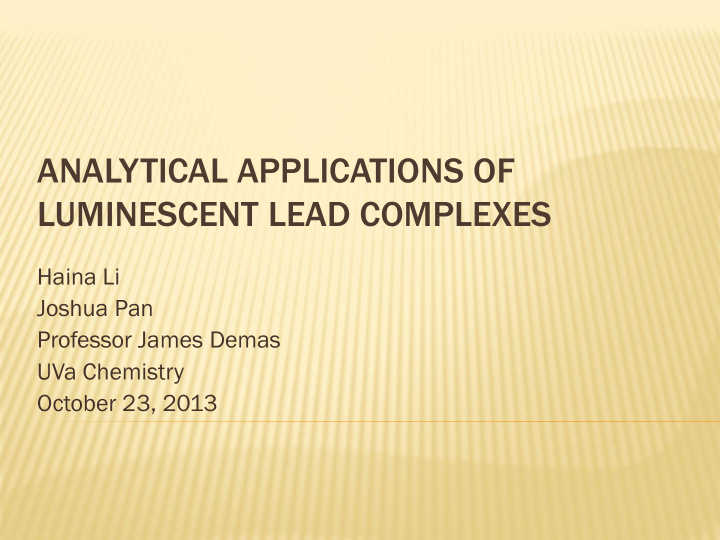



ANALYTICAL APPLICATIONS OF LUMINESCENT LEAD COMPLEXES Haina Li Joshua Pan Professor James Demas UVa Chemistry October 23, 2013
OUTLINE Previous Work What is Luminescence? Identifying Emitting Species
PREVIOUS WORK Pb 2+ + Br - ⇿ Pb 4 Br 11 3-
LUMINESCENCE Emits green (550nm), peak absorption at 350nm Jobin Yvon Spectrofluorometer
PREVIOUS WORK 1000 nM lead 6.00E+05 5.00E+05 [Pb 2+ ] Intensity (CPS) 4.00E+05 3.00E+05 450 nM lead 2.00E+05 1.00E+05 0 nM lead 0.00E+00 420 470 520 570 620 Wavelength (nm)
ZINC 300000 0 mM Zinc 250000 sity (CPS) 200000 ensity 150000 [Zn 2+ ] 1 mM Zinc Inten 100000 50000 0 450 500 550 600 650 Wavel elen ength gth (nm) 3- ⇿ Pb w Br x + Zn y Br z Zn 2+ + Pb 4 Br 11
BROMIDE IONS 700000 0.03 M 600000 500000 y (CPS) [Bromide ion] 400000 ity ensit Intens 300000 200000 0.003 M 100000 0 450 500 550 600 650 Wavel elen ength gth (nm) Pb x Br y ⇿ Br - + Pb a Br b
Pb x Br y ⇿ Br - +Pb a Br b 2- ⇿ Br - +PbBr 3 - PbBr 4
1.2 1.2 320 350 550 600 ty ty ensity 1 1 ensity ed Intens ized Inten 0.8 0.8 0.6 malized 0.6 malized Normali 0.4 0.4 Norma 0.2 0.2 0 0 300 350 400 450 500 550 600 150 350 550 Wavele velength gth (nm) Wavel elen ength gth (nm) PbBr 3 - PbBr 4 2- 550 600 350 320
Pb 4 Br 11 3- Pb 2+ + Br - ⇿ Pb 4 Br 11 3-
Pb 2+ + Br - 2- ⇿ Br - +PbBr 3 - PbBr 4 PbBr 3 - PbBr 4 2-
CONCLUSION PbBr 3 - and PbBr 4 2- No Pb 4 Br 11 3- Does not affect our previous methods for lead quantification Future Work: Better Design the System
ACKNOWLEDGEMENT Dr. James Demas, Joshua Pan UVA Chemistry Department UVA College Science Scholars Program: Many thanks go to the generous donors to the College Science Scholars program who make these summer research awards possible: Charles Henry Leach, II, Foundation, Mr. Steve Van Besien; Entigence Corporation; Lois A. Fitton & W. Christopher Draper, Jr.; Sharon B. Parente & John W. Risner; The Jefferson Trust; Robert Atkinson; Dean’s discretionary gifts
Recommend
More recommend